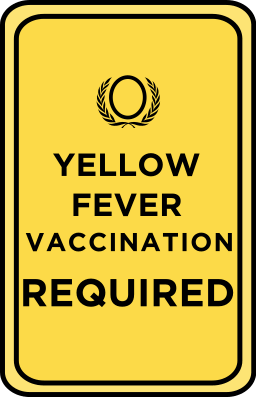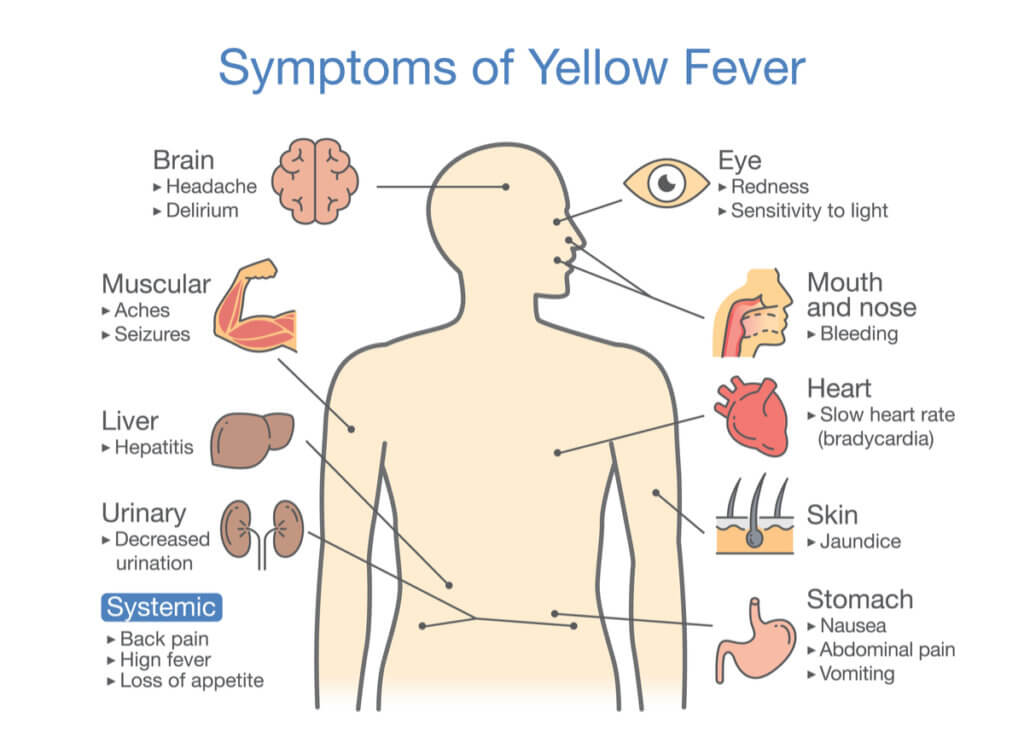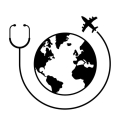
[ez-toc]
What is Yellow Fever?
Yellow fever is a viral disease that spreads to people through bites from infected mosquitos. It is found in subtopical and tropical regions of South America and Africa.
Thee yellow fever virus causes flu-like symptoms that include fever, chills, nausea, vomiting, gas, and indigestion. It is one of the small RNA viruses that are classified in the family Flaviviridae.
While most cases of yellow fever are mild and resolve without treatment, the disease can sometimes progress to become life-threatening.
Fortunately, yellow fever can be prevented through vaccination. The yellow fever vaccine is effective especially if taken a month before traveling, and it gives you protection for life.
What are the symptoms of Yellow Fever?
There is no way to kill the virus if you contract the disease. Doctors can only treat the symptoms and give supportive care. About half of the people who contract Yellow Fever die.
Symptoms of yellow fever typically include fever, chills, headache, muscle aches, and nausea. In severe cases, the disease can lead to liver failure, jaundice (yellowing of the skin and eyes), and bleeding from the mouth, nose, and eyes.
It is therefore important to be aware of the illness and take steps to avoid infection.

The virus is transmitted among humans and mosquitoes but also among other primates and mosquitoes. Infected people can also transmit the virus to other mosquitoes when they are bitten.
Only certain species of mosquitoes can carry the yellow fever virus and transmit the disease to people. The most well-known and most common vectors of the yellow fever disease are the mosquitoes Aedes aegypti and Haemagogus species.
How to prevent Yellow Fever
The best way to prevent getting yellow fever is to get vaccinated if you plan to travel to an area where the illness is known to occur.
Vaccination is recommended for people older than 9 months and younger than 60 years. However, pregnant women, people older than 60 years, and those with a weak immune system should not get the vaccine.
You can also wear long-sleeved clothing and use bug repellent to try to prevent being bitten by mosquitoes. If possible you should also avoid being active when mosquitoes are most active.
You are also at higher risk if you stay in rural areas or in forested regions where yellow fever is present, and if you are outside at dawn and dusk when mosquitoes are most active.
Countries with risk of Yellow Fever transmission
People traveling to tropical and subtropical regions in Africa and South America are at greater risk of catching the yellow fever virus and becoming ill.
In fact, some countries may require proof of vaccination for entry, so do your research and check beforehand if you plan to travel to a high-risk country.
The South American countries where yellow fever vaccination is strongly recommended by the CDC include Columbia, Venezuela, French Guiana, Guyana, Suriname, Peru, Bolivia, Ecuador, Paraguay, and Brazil.
Vaccination is also recommended if you are visiting western and central regions of Africa including Guinea, Sierra Leone, Togo, Ghana, Burkina Faso, Cote d’Ivoire, Liberia, Senegal, Gambia, Cameroon, Nigeria, Central African Republic, Democratic Republic of Congo, Rwanda, Burundi, Uganda, Kenya, Angola, Gabon, Republic of Congo, and Sudan.
History of Yellow Fever
Yellow fever has a long history of causing outbreaks and epidemics in many parts of the world, especially in Africa and the Americas.
While the origins of yellow fever are unclear, it is believed to have been present in Africa for thousands of years. The first recorded outbreak of yellow fever in the Americas occurred in 1648 in the Yucatán Peninsula of Mexico. The disease then spread throughout the Caribbean and eventually to the mainland of South and Central America.
During the 18th and 19th centuries, yellow fever was a major health concern in many port cities in the Americas, including New Orleans, Havana, Rio de Janeiro, and others. Outbreaks of the disease often occurred during warm, mosquito-friendly months and were associated with increased trade and travel.
In the late 19th and early 20th centuries, major progress was made in understanding the transmission of yellow fever. In 1881, Carlos Finlay, a Cuban physician, suggested that mosquitoes were responsible for spreading the disease. This idea was confirmed in 1900 by Walter Reed, an American physician, who led a team of researchers in conducting experiments that proved the mosquito-borne transmission of yellow fever.
Thanks to these findings, public health measures were put in place to control the spread of the disease, including mosquito control and vaccination programs. Today, yellow fever is still a significant public health concern in many parts of the world, particularly in Africa and South America. However, through efforts to control the mosquitoes that transmit the disease and widespread vaccination, the impact of yellow fever has been greatly reduced.
References:
https://www.sciencedirect.com/science/article/pii/S1473309901000160
https://www.karger.com/Article/Abstract/149642
https://www.cabdirect.org/cabdirect/abstract/19442900678
https://www.cdc.gov/yellowfever/maps/africa.html
https://www.cdc.gov/yellowfever/maps/south_america.html
https://www.canada.ca/en/public-health/services/diseases/yellow-fever.html
https://www.who.int/news-room/fact-sheets/detail/yellow-fever

